Issue #53: Provisioning When You Aren’t Headed to Flavortown
Morning Glory Muffins in My Hotel Room, Remembering Mango Salsa
Issue #53 has arrived! (I haven’t decided whether to use the fuddy-duddy “Volume 2, Issue 1” numbering convention of traditional periodicals.) Thanks go out to those who have renewed or are planning to. And a big Welcome! to new readers. I hope you enjoy these epicurean escapades. Even more, I hope you cook. —Mitchell
This week’s newsletter is coming to you from The Fenway, an historic hotel in Dunedin, Florida. I’m here for a workshop of the Taoist Tai Chi Society of the USA, an organization for which I serve on the national board. Several years ago the Taoist Tai Chi Society redeveloped this large piece of property on the gulf coast of Florida’s Pinellas peninsula. The site includes our International Center and practice hall, as well as this lovely hotel, operated as part of Marriott Autograph Collection, where some of our participants stay during workshops and other events. I’ve been here many times, but not since before the pandemic.
Dunedin is a small, somewhat sleepy town, just north of St. Pete’s. It’s the spring training home of the Toronto Blue Jays and a tourist destination in its own right due to the natural beauty, the warm weather, and the walkable downtown, a central feature of which is the Pinellas Trail, a walking and bike path that cuts right through the main strip and stretches 45 miles along the peninsula.
But Dunedin is not a food town. Sure, there are lots of busy restaurants, many of them seafood spots or bars. There are several brew pubs. These places can be fun with a large group. The service is friendly. But the food is not the focus and it is best not to focus on it. Consider this “Greek salad,” I ordered to take out from a seafood place on the water. I ordered a salad because it was hard to believe the scallops, lobster, or ahi tuna were going to be good. They certainly weren’t going to be local. Still, nothing explains the large scoop of potato salad that was plopped down in the middle of my salad.
Whenever I’m traveling to a place that isn’t known to be a food destination, I provision myself accordingly. I usually pack nuts, dried fruit, some sourdough bread, cheese, and other snacks that can hold me over. I realize this makes me a food snob in some people’s eyes. But I’m okay with that. It’s not that I’m looking for something fancy. Quite the reverse. I’m looking for something simple enough to be good, something that doesn’t sound like it was made by a contestant on Chopped.
I do like to support the local economy, however, so I always go exploring. In Dunedin, I’ve found fabulous homemade ice cream at Strachan’s, piles of delicious stone crab claws from Jensens Brothers Seafood shop (sadly out of season this time of year), and a respectable slice of New York style pizza at Tony’s.
Because I was going to be here in Dunedin for five days for this tai chi workshop and because we were responsible for all our own meals due to the pandemic (usually we cook together for the group), I came prepared. I baked a batch of excellent Morning Glory muffins from the King Arthur website so that along with yogurt and fresh fruit, which I purchased locally at Nature’s Food Patch Market, I had something tasty and healthful for breakfast in my room. These muffins are 100% whole grain. They include carrots, apples, raisins, and walnuts, which makes them sort of like a serving of granola, fruit, and vegetables in neat little muffin package. They also keep really well at room temperature, staying moist and fresh for 4 or 5 days if well wrapped. They also remind me of muffins I enjoyed as a kid during the 1980s, when the muffin trend was hot in Toronto. (For more of my muffin memories, see recipes for Chocolate Chocolate Chip and Lemon Sour Cream Blueberry muffins in previous issues.)
RECIPE: King Arthur’s Moring Glory Muffins
Makes 12 large muffins. Recipe can be halved, which helps prevent what my husband calls “muffin ennui.”
1/2 cup walnut halves or pieces
1/2 cup raisins
2 cups whole wheat flour or a combination of whole wheat and spelt, rye, einkorn or whatever you’d like to use (gluten-free flour also works)
1 cup light or dark brown sugar, packed
2 teaspoons baking soda
2 teaspoons cinnamon
1/2 teaspoon ginger
1/2 teaspoon salt
2 large carrots, peeled and grated (about 2 cups)
1 large, tart apple, peeled and grated (about 1 cup)
1/2 cup shredded coconut, sweetened or not (optional)
1/3 cup sunflower seeds, roasted but not salted
2 tablespoon wheat germ or oat bran
3 large eggs
2/3 cup vegetable oil, such peanut, olive, avocado, canola, or a combination
2 teaspoons vanilla extract
1/4 cup fresh apple or orange juice
Preheat the oven to 375°F. Place the walnuts on a small tray and set in the preheating oven to toast for about 10 minutes, until they smell nutty. Remove, cool, and chop. Line a muffin tin with papers and spray the insides of the papers and the top of the tin with nonstick spray. Place the raisins in a small bowl, cover with water, and let soak while you continue.
In a large bowl, combine the flour(s), brown sugar, baking soda, cinnamon, ginger, and salt, using a whisk to blend. With a wooden spoon or rubber spatula, stir in the grated carrot, grated apple, shredded coconut, if using, toasted nuts, sunflower seeds, and wheat germ. In a separate bowl, whisk together the eggs, oil, vanilla, and juice. Add this liquid mixture to the flour mixture, and using the wooden spoon or rubber spatula, mix until everything is moistened. Drain the raisins and stir them into the batter.
Divide the batter evenly among the 12 prepared cups. It will come to the top. Bake the muffins for 25 to 30 minutes, until they're nicely domed, firm to the touch, and an instant-read thermometer inserted into a muffin in the middle of the pan reads at least 200°F. and comes out clean.
Remove from the oven, let cool for 5 minutes in the pan on a rack, then ease the muffins out of the pan and onto the rack to finish cooling. The muffins are best just baked, but they keep really well in an airtight container at room temperature for 4 or 5 days or longer in the fridge. They can be frozen for a couple of months.
Another Food Memory from the 1980s
Speaking of the 1980s, in the prepared food section of the refrigerator at Dunedin’s Natures Food Patch, I spotted something I haven’t seen or thought of since about the time Morning Glory Muffins were popular: mango salsa. In trendy restaurants in Toronto of that era, just about anything grilled—swordfish, grouper, mahi-mahi, tuna, shrimp, chicken—came with a mango or other fruit salsa. This was “fancy,” a kind of mishmash of trends from California, the Southwest, and what some began calling New Floribbean cuisine.
As I’ve mentioned in this newsletter before, I worked for a period during the late 1980s as a grill cook at the swank Rhodes bistro in Toronto, which always attracted celebrities in town for the fledgling Toronto Film Festival. Grilled whatever-fish with fruit salsa was often our “Catch of the Day.” It was made all the more special served on a large, white, wide-rimmed plate garnished with frizzled leeks. Those were the days. I hadn’t thought of mango salsa much since then.
I scanned the ingredients of this is mango salsa in the refrigerator case: Florida mangoes (!), tomatoes, red onions, canola oil, cayenne pepper, and salt. All natural. I bought it and scarfed it down with a bag of pretzel chips. A fond and delicious memory.
Here, then, is a recipe for the kind of fruit salsa I used to make at Rhodes. This is just a guideline because you can use almost any fruit in the mix. Make sure it is ripe. You can also use any herb, but I like it best with cilantro. (My new, generous, hawkeyed, volunteer proofreader Carol just made a mango salsa with cumin, so feel free to make this your own.) Some or all of the ingredients can be grilled if you want to go to the trouble and you like the taste of a little char. But there is no need. I think the only other advice is to chop everything the same size. I prefer a fine dice so that each mouthful contains a balance of ingredients, but a chunkier salsa is also nice sometimes. This salsa is good on grilled meat and fish, or just on its own with chips.
RECIPE: Fruit Salsa
2 medium ripe mangoes, peeled and finely diced (about 1 1/2 cups), or an equivalent amount of other fresh, ripe fruit, such as melon, plums, peaches, cherries, or what have you
1 large red or yellow tomato, seeded and finely diced
½ large red onion, finely diced
½ red, yellow, or orange bell pepper, seeded and diced
1 small jalapeño or serrano pepper, seeded and finely diced (more or less, to taste)
1 small bunch cilantro, including tender stems, finely chopped
3 tablespoons extra-virgin olive or avocado oil
3 tablespoons white or red wine vinegar
Salt
Freshly ground black pepper
In a medium bowl, combine the diced mango or other fruit, tomato, red onion, bell pepper, jalapeño, cilantro, oil and vinegar. Add a nice pinch of salt and a generous amount of freshly ground black pepper. Taste and adjust the balance with more vinegar, oil, salt, and/or pepper. The salsa is best eaten in a couple of days but it will keep a week or more.
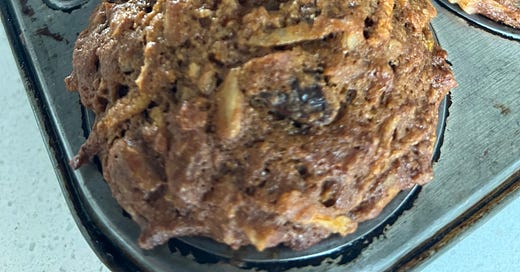


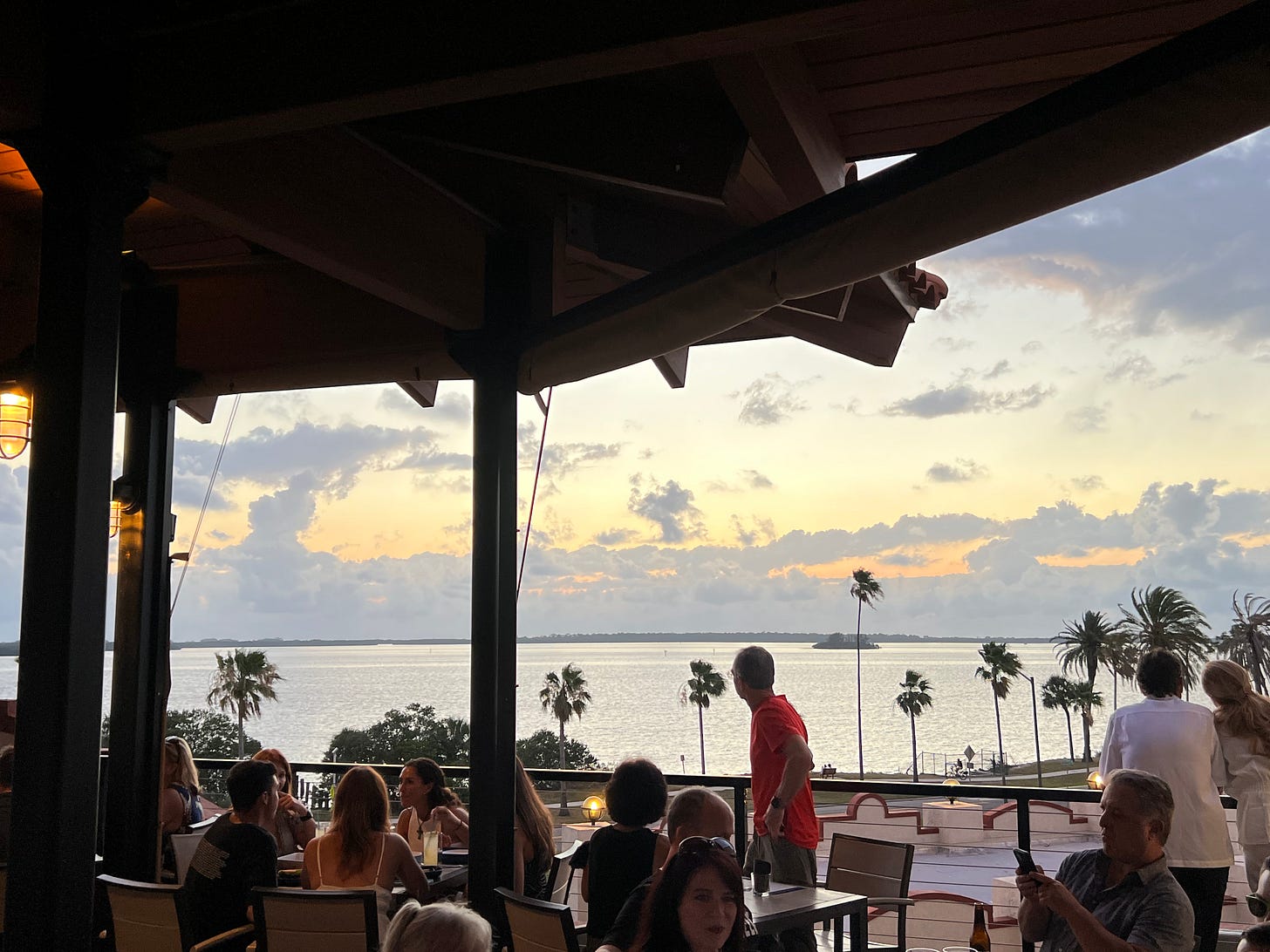
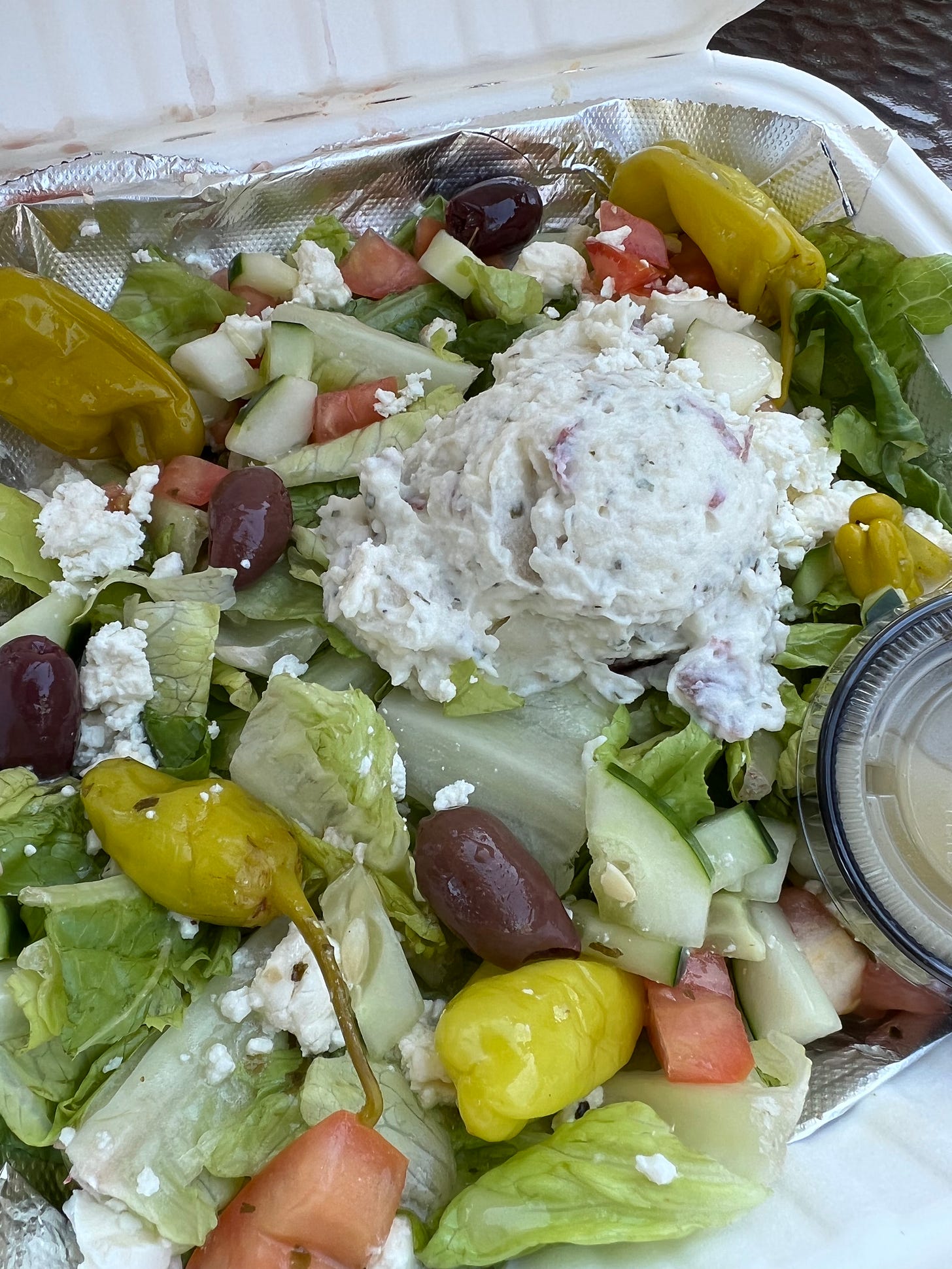
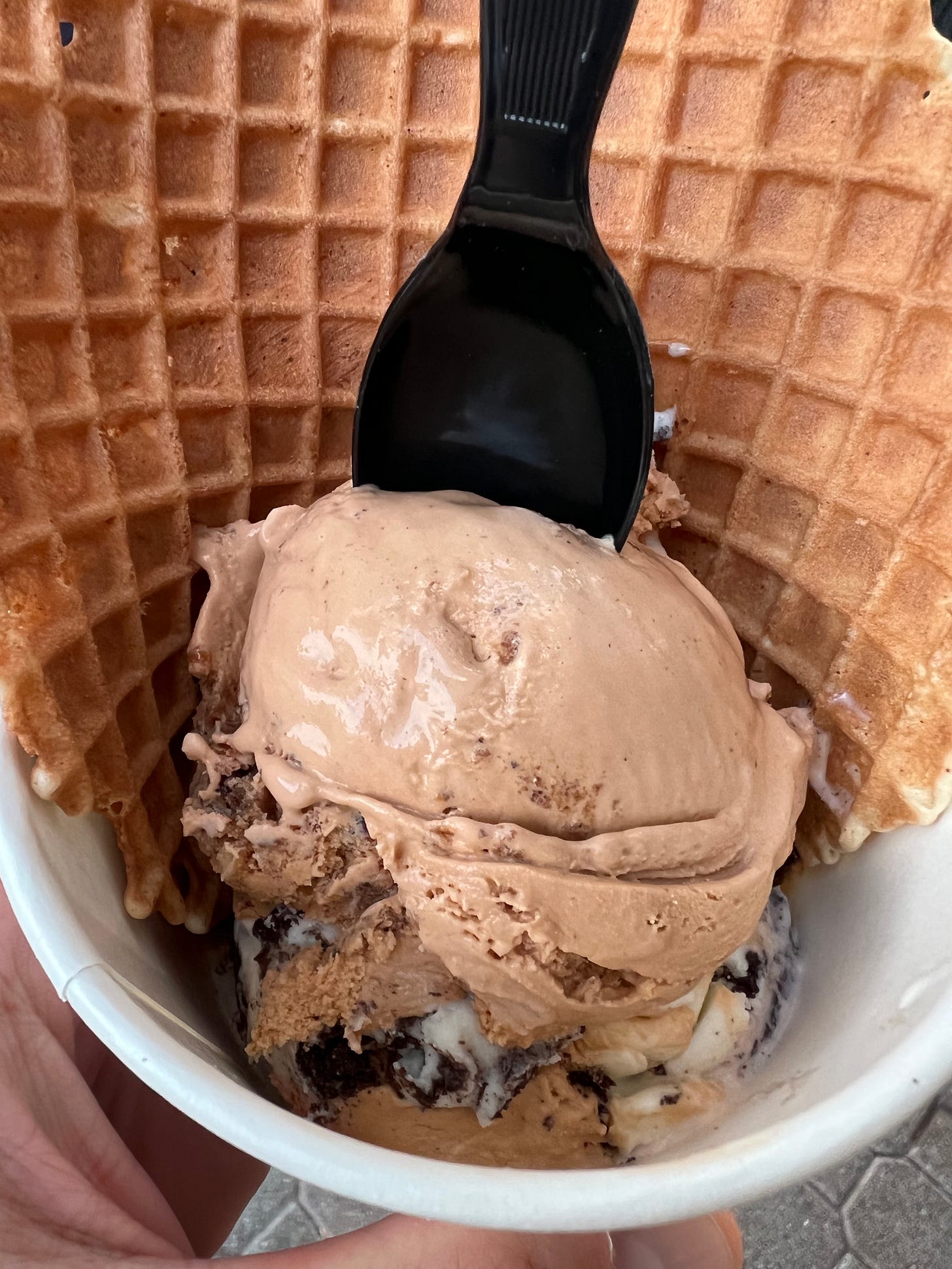

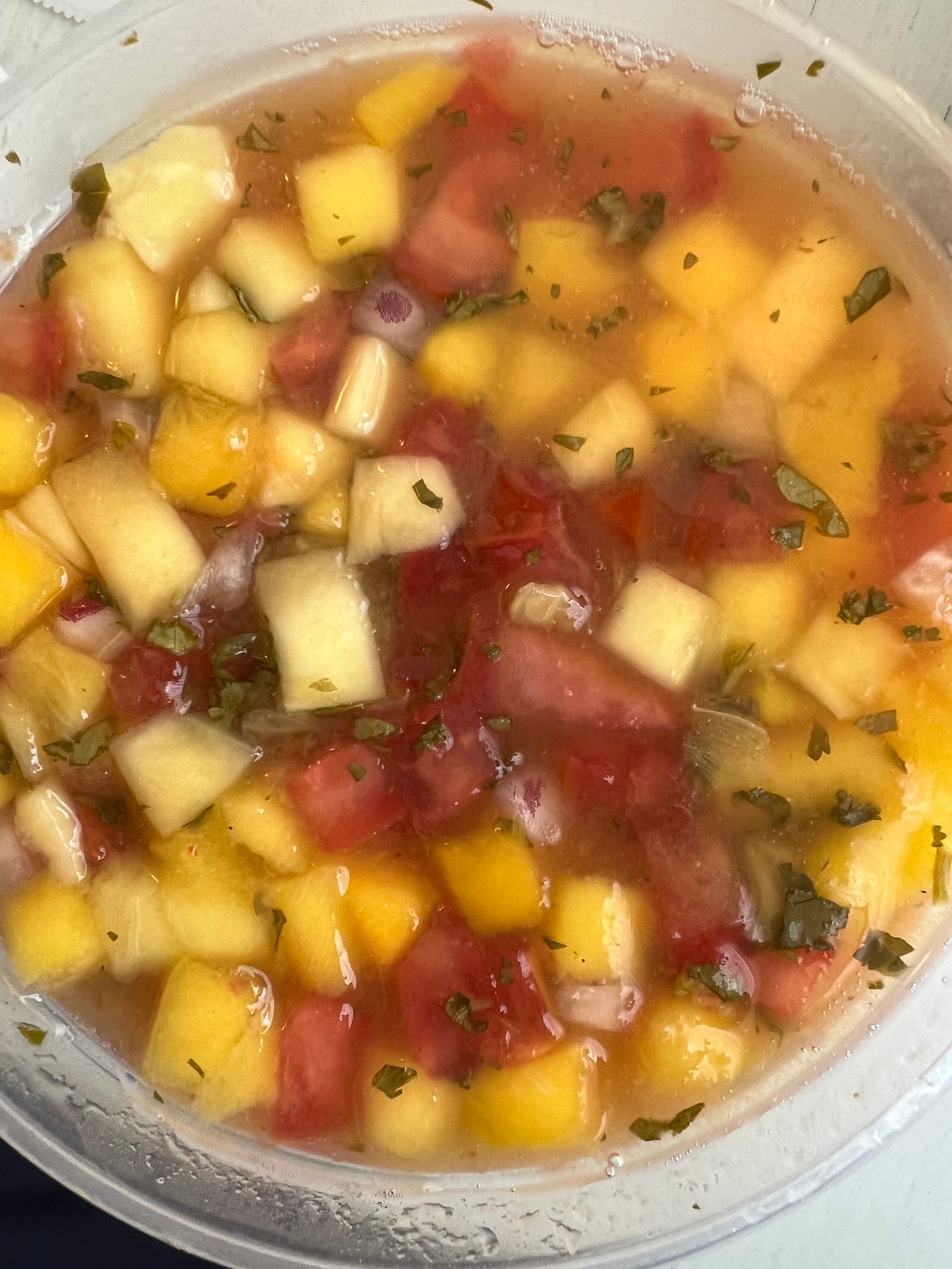
If you are still in Dunedin, you need to continue your culinary quests. Because of your failure, I have to lower your position on my Highly Esteemed Pedestal down a notch or two. But, first, whisper to your hawkeyed proofreader she missed the missing N in Morning Glory.
Now about the potato salad in the Greek Salad or whatever it was called. Drive a few miles north to Tarpon Springs, talk to the proprietors of some of the Sponge Dock restaurants, and you will learn historically significant reasons -- culinary, cultural, and economic -- why potato salad has a rather revered placement in this salad.
A fellow seeker on this never-ending journey for "why this food in this place" -- Marcie